fuel cap TOYOTA CAMRY 2021 Owners Manual (in English)
[x] Cancel search | Manufacturer: TOYOTA, Model Year: 2021, Model line: CAMRY, Model: TOYOTA CAMRY 2021Pages: 660, PDF Size: 16.97 MB
Page 3 of 660
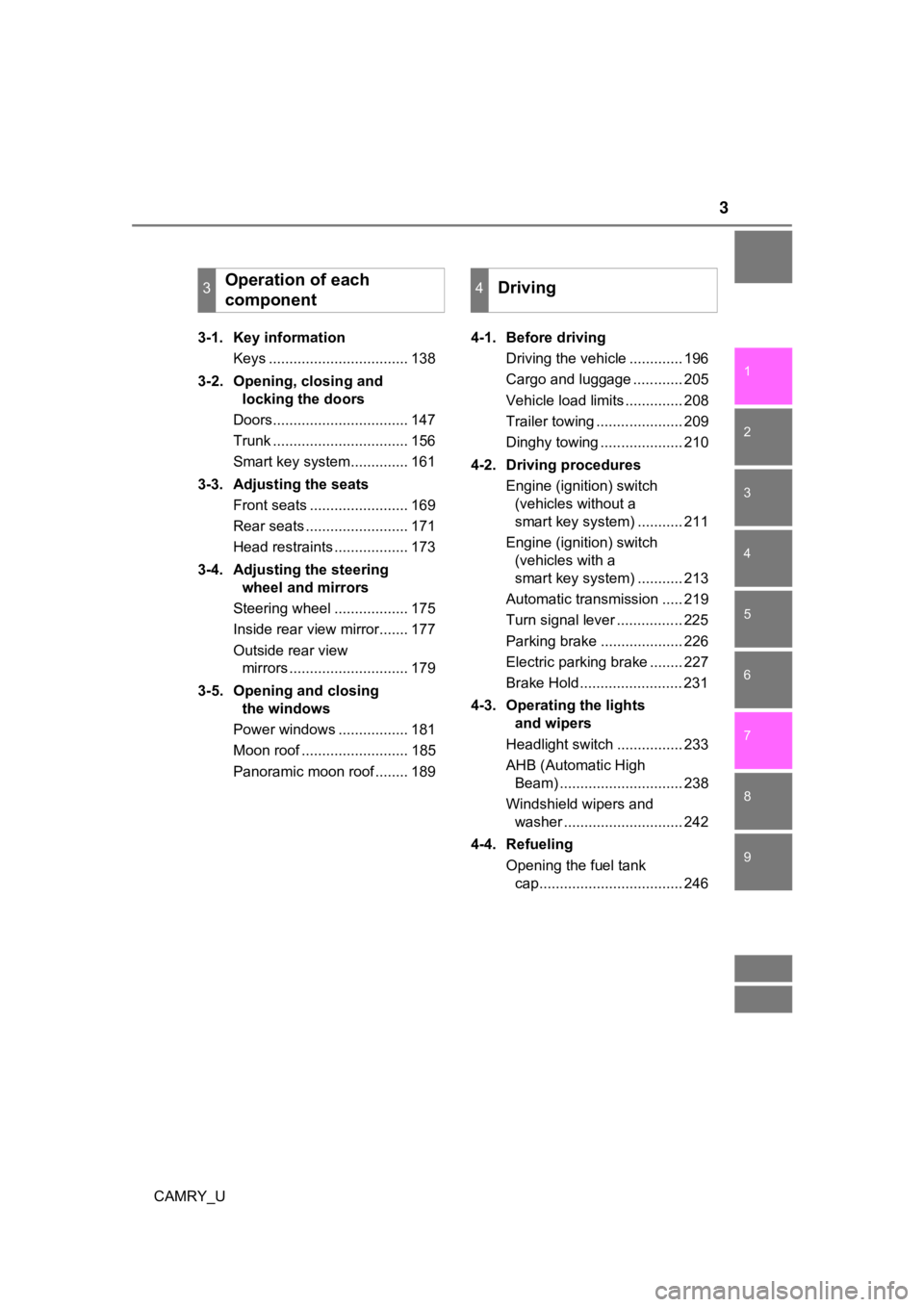
3
1
8 7 5 4
3
2
CAMRY_U
9
6
3-1. Key informationKeys .................................. 138
3-2. Opening, closing and locking the doors
Doors................................. 147
Trunk ................................. 156
Smart key system.............. 161
3-3. Adjusting the seats Front seats ........................ 169
Rear seats ......................... 171
Head restraints .................. 173
3-4. Adjusting the steering wheel and mirrors
Steering wheel .................. 175
Inside rear view mirror....... 177
Outside rear view mirrors ............................. 179
3-5. Opening and closing the windows
Power windows ................. 181
Moon roof .......................... 185
Panoramic moon roof ........ 189 4-1. Before driving
Driving the vehicle ............. 196
Cargo and luggage ............ 205
Vehicle load limits .............. 208
Trailer towing ..................... 209
Dinghy towing .................... 210
4-2. Driving procedures Engine (ignition) switch (vehicles without a
smart key system) ........... 211
Engine (ignition) switch (vehicles with a
smart key system) ........... 213
Automatic transmission ..... 219
Turn signal lever ................ 225
Parking brake .................... 226
Electric parking brake ........ 227
Brake Hold ......................... 231
4-3. Operating the lights and wipers
Headlight switch ................ 233
AHB (Automatic High Beam) .............................. 238
Windshield wipers and washer ............................. 242
4-4. Refueling Opening the fuel tank cap................................... 246
3Operation of each
component4Driving
Page 15 of 660
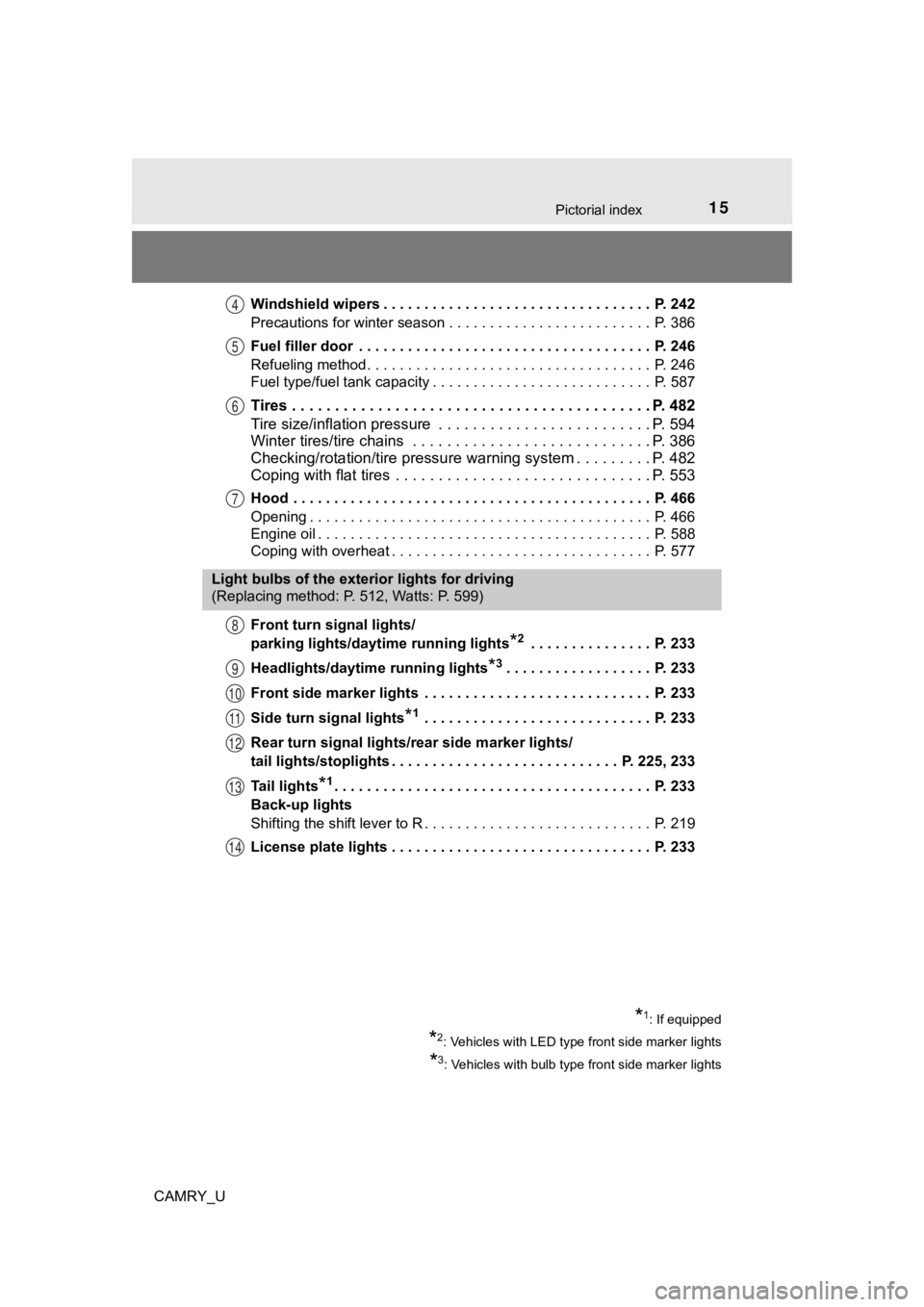
15Pictorial index
CAMRY_UWindshield wipers . . . . . . . . . . . . . . . . . . . . . . . . . . . . . . . . . P. 242
Precautions for winter season . . . . . . . . . . . . . . . . . . . . . . . . . P. 386
Fuel filler door . . . . . . . . . . . . . . . . . . . . . . . . . . . . . . . . . . . . P. 246
Refueling method . . . . . . . . . . . . . . . . . . . . . . . . . . . . . . . . . . . P. 246
Fuel type/fuel tank capacity . . . . . . . . . . . . . . . . . . . . . . . . . . . P. 587
Tires . . . . . . . . . . . . . . . . . . . . . . . . . . . . .
. . . . . . . . . . . . . P. 482
Tire size/inflation pressure . . . . . . . . . . . . . . . . . . . . . . . . . P. 594
Winter tires/tire chains . . . . . . . . . . . . . . . . . . . . . . . . . . . . P. 386
Checking/rotation/tire pressur e warning system . . . . . . . . .P. 482
Coping with flat tires . . . . . . . . . . . . . . . . . . . . . . . . . . . . . . P. 553
Hood . . . . . . . . . . . . . . . . . . . . . . . . . . . . . . . . . . . . . . . . . . . . P. 466
Opening . . . . . . . . . . . . . . . . . . . . . . . . . . . . . . . . . . . . . . . . . . P. 466
Engine oil . . . . . . . . . . . . . . . . . . . . . . . . . . . . . . . . . . . . . . . . . P. 588
Coping with overheat . . . . . . . . . . . . . . . . . . . . . . . . . . . . . . . . P. 577
Front turn signal lights/
parking lights/daytime running lights
*2 . . . . . . . . . . . . . . . P. 233
Headlights/daytime running lights
*3. . . . . . . . . . . . . . . . . . P. 233
Front side marker lights . . . . . . . . . . . . . . . . . . . . . . . . . . . . P. 233
Side turn signal lights
*1 . . . . . . . . . . . . . . . . . . . . . . . . . . . . P. 233
Rear turn signal lights/r ear side marker lights/
tail lights/stoplights . . . . . . . . . . . . . . . . . . . . . . . . . . . . P. 225, 233
Tail lights
*1. . . . . . . . . . . . . . . . . . . . . . . . . . . . . . . . . . . . . . . P. 233
Back-up lights
Shifting the shift lever to R . . . . . . . . . . . . . . . . . . . . . . . . . . . . P. 219
License plate lights . . . . . . . . . . . . . . . . . . . . . . . . . . . . . . . . P. 233
4
5
6
7
Light bulbs of the exterior lights for driving
(Replacing method: P. 512, Watts: P. 599)
8
9
10
11
12
13
14
*1: If equipped
*2: Vehicles with LED type front side marker lights
*3: Vehicles with bulb type front side marker lights
Page 195 of 660
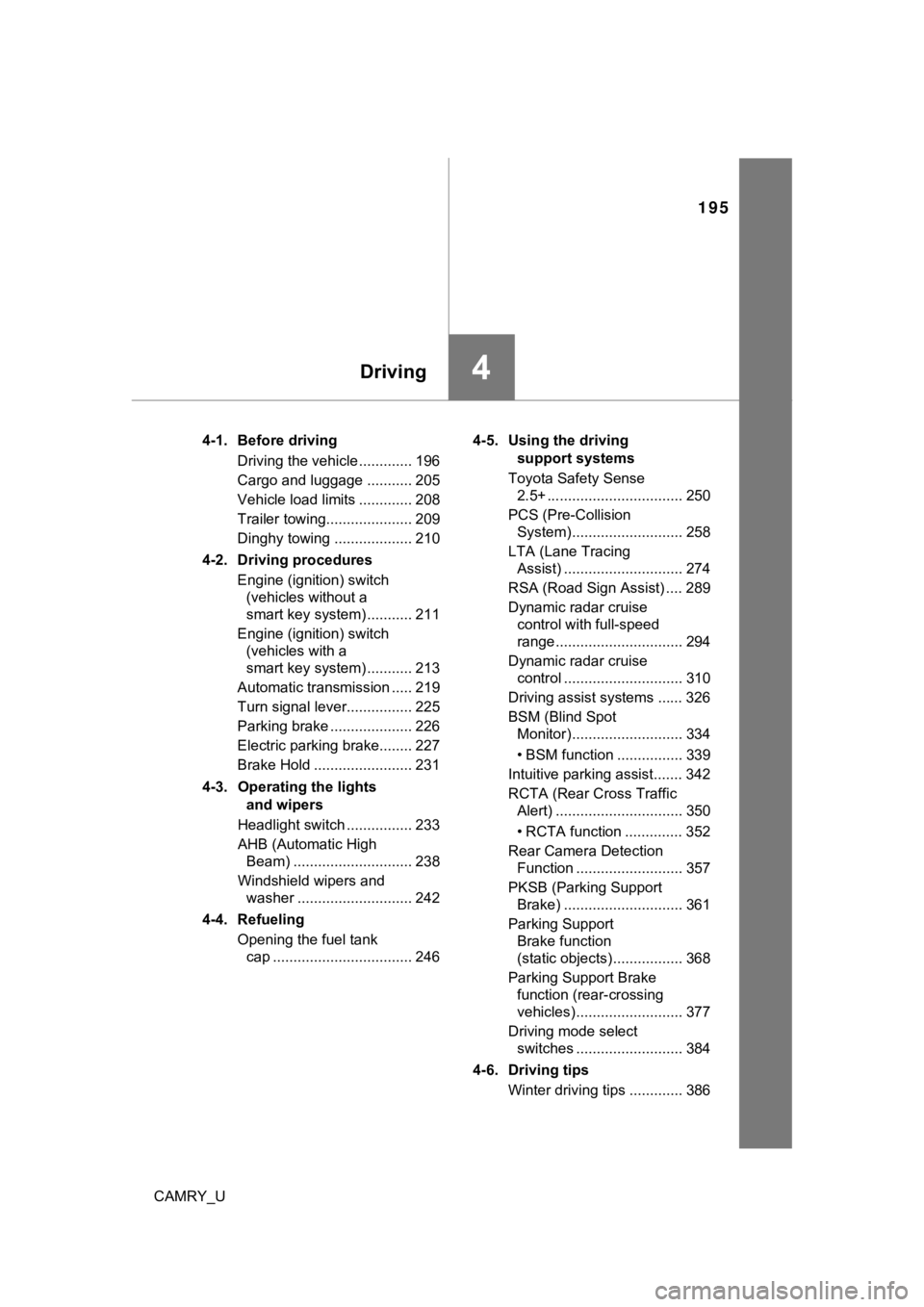
195
4Driving
CAMRY_U4-1. Before driving
Driving the vehicle ............. 196
Cargo and luggage ........... 205
Vehicle load limits ............. 208
Trailer towing..................... 209
Dinghy towing ................... 210
4-2. Driving procedures Engine (ignition) switch (vehicles without a
smart key system) ........... 211
Engine (ignition) switch (vehicles with a
smart key system) ........... 213
Automatic transmission ..... 219
Turn signal lever................ 225
Parking brake .................... 226
Electric parking brake........ 227
Brake Hold ........................ 231
4-3. Operating the lights and wipers
Headlight switch ................ 233
AHB (Automatic High Beam) ............................. 238
Windshield wipers and washer ............................ 242
4-4. Refueling Opening the fuel tank cap .................................. 246 4-5. Using the driving
support systems
Toyota Safety Sense 2.5+ ................................. 250
PCS (Pre-Collision System)........................... 258
LTA (Lane Tracing Assist) ............................. 274
RSA (Road Sign Assist) .... 289
Dynamic radar cruise control with full-speed
range............................... 294
Dynamic radar cruise control ............................. 310
Driving assist systems ...... 326
BSM (Blind Spot Monitor)........................... 334
• BSM function ................ 339
Intuitive parking assist....... 342
RCTA (Rear Cross Traffic Alert) ............................... 350
• RCTA function .............. 352
Rear Camera Detection Function .......................... 357
PKSB (Parking Support Brake) ............................. 361
Parking Support Brake function
(static objects)................. 368
Parking Support Brake function (rear-crossing
vehicles).......................... 377
Driving mode select switches .......................... 384
4-6. Driving tips Winter driving tips ............. 386
Page 212 of 660
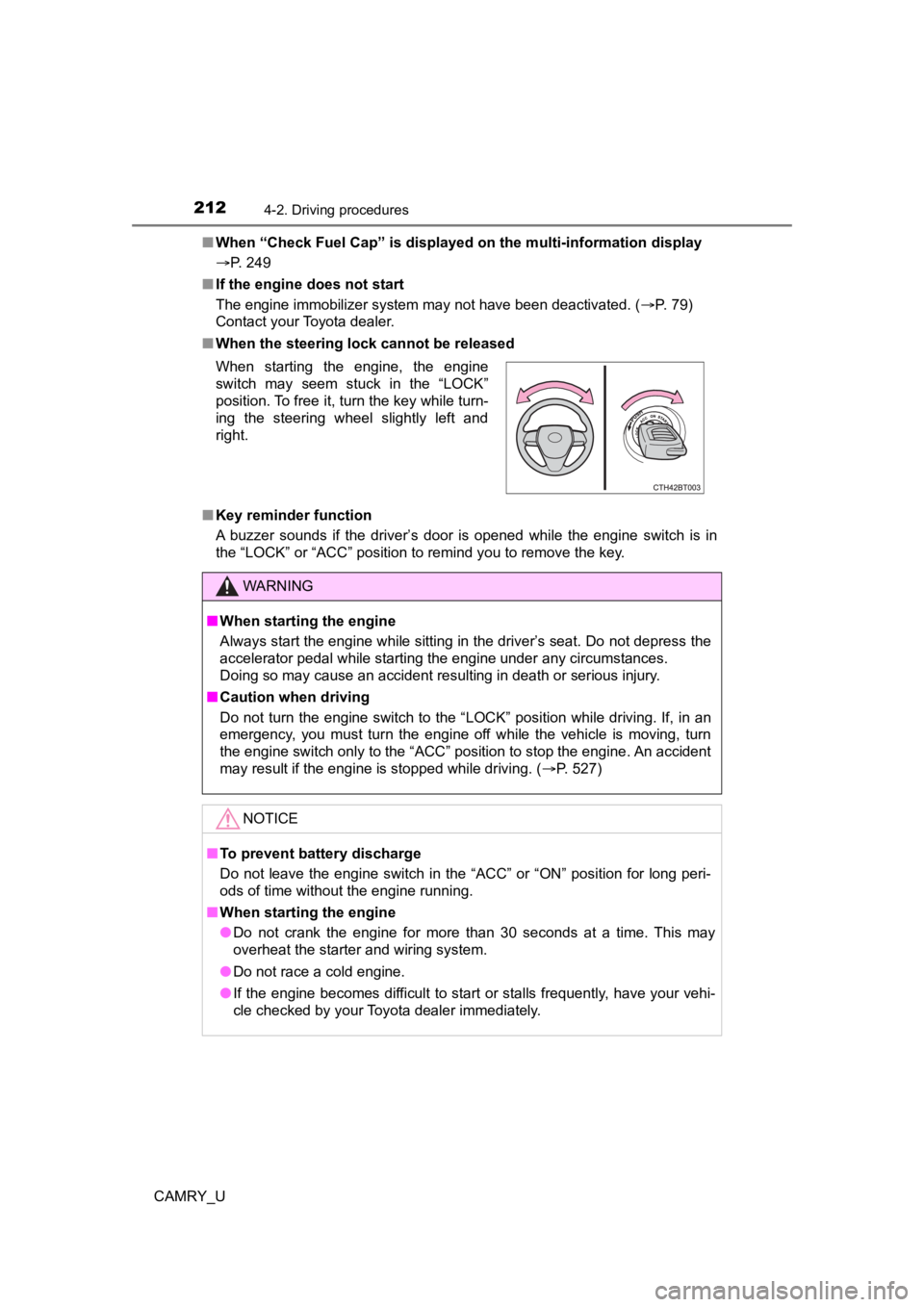
2124-2. Driving procedures
CAMRY_U■
When “Check Fuel Cap” is displayed on the multi-information dis play
P. 249
■ If the engine does not start
The engine immobilizer system may not have been deactivated. ( P. 79)
Contact your Toyota dealer.
■ When the steering lock cannot be released
■ Key reminder function
A buzzer sounds if the driver’s door is opened while the engine switch is in
the “LOCK” or “ACC” position to remind you to remove the key. When starting the engine, the engine
switch may seem stuck in the “LOCK”
position. To free it, turn the key while turn-
ing the steering wheel slightly left and
right.
WARNING
■ When starting the engine
Always start the engine while sitting in the driver’s seat. Do not depress the
accelerator pedal while starting the engine under any circumsta nces.
Doing so may cause an accident resulting in death or serious in jury.
■ Caution when driving
Do not turn the engine switch to the “LOCK” position while driving. If, in an
emergency, you must turn the engine off while the vehicle is moving, turn
the engine switch only to the “ACC” position to stop the engine . An accident
may result if the engine is stopped while driving. ( P. 527)
NOTICE
■To prevent battery discharge
Do not leave the engine switch in the “ACC” or “ON” position fo r long peri-
ods of time without the engine running.
■ When starting the engine
● Do not crank the engine for more than 30 seconds at a time. This may
overheat the starter and wiring system.
● Do not race a cold engine.
● If the engine becomes difficult to start or stalls frequently, have your vehi-
cle checked by your Toyota dealer immediately.
Page 216 of 660
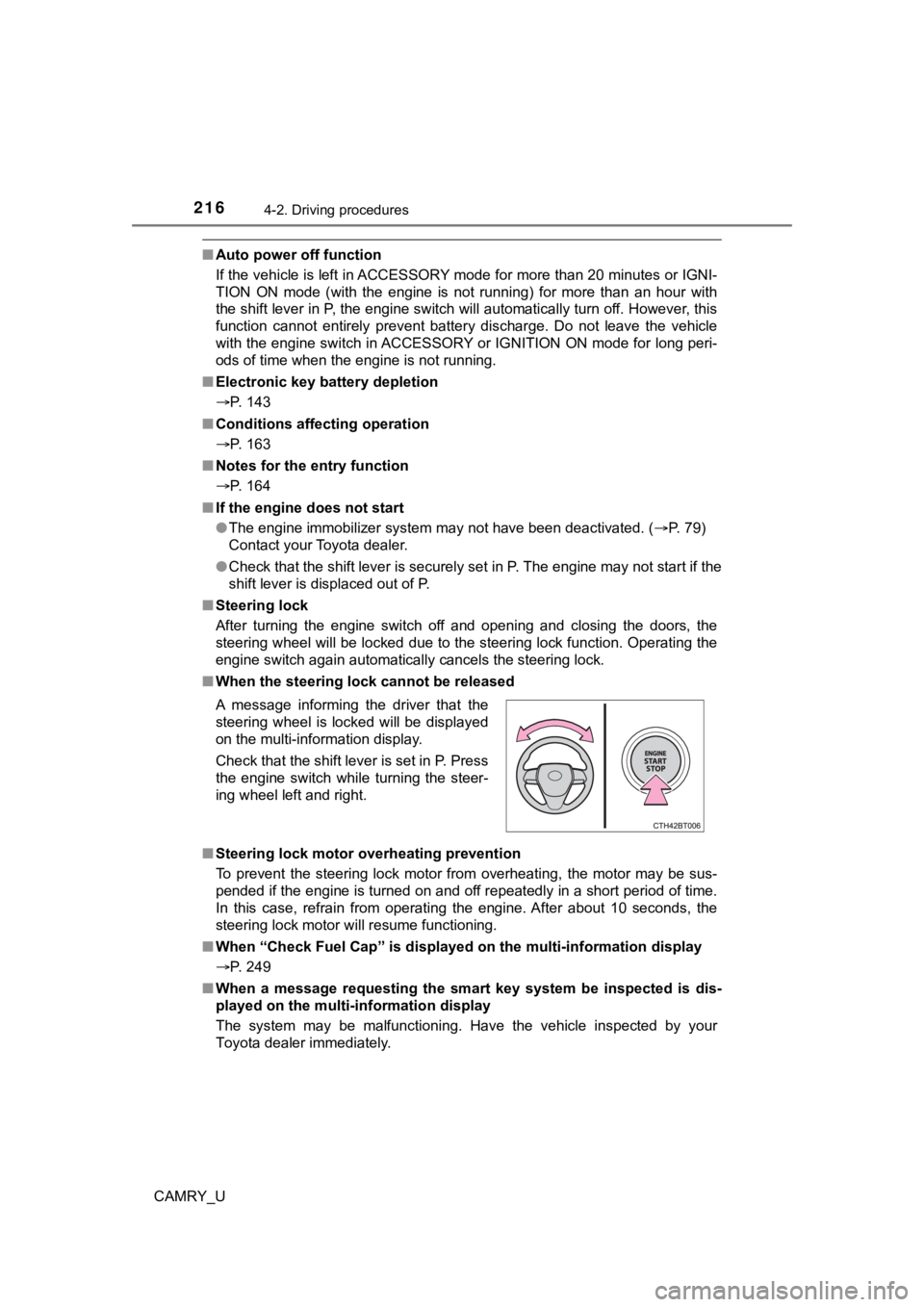
2164-2. Driving procedures
CAMRY_U
■Auto power off function
If the vehicle is left in ACCESSORY mode for more than 20 minut es or IGNI-
TION ON mode (with the engine is not running) for more than an hour with
the shift lever in P, the engine switch will automatically turn off. However, this
function cannot entirely prevent battery discharge. Do not leav e the vehicle
with the engine switch in ACCESSORY or IGNITION ON mode for lon g peri-
ods of time when the engine is not running.
■ Electronic key battery depletion
P. 143
■ Conditions affecting operation
P. 163
■ Notes for the entry function
P. 164
■ If the engine does not start
●The engine immobilizer system may not have been deactivated. ( P. 79)
Contact your Toyota dealer.
● Check that the shift lever is securely set in P. The engine may not start if the
shift lever is displaced out of P.
■ Steering lock
After turning the engine switch off and opening and closing the doors, the
steering wheel will be locked due to the steering lock function. Operating the
engine switch again automatically cancels the steering lock.
■ When the steering lock cannot be released
■ Steering lock motor overheating prevention
To prevent the steering lock motor from overheating, the motor may be sus-
pended if the engine is turned on and off repeatedly in a short period of time.
In this case, refrain from operating the engine. After about 10 seconds, the
steering lock motor will resume functioning.
■ When “Check Fuel Cap” is displayed on the multi-information display
P. 249
■ When a message requesting the smart key system be inspected is dis-
played on the multi-information display
The system may be malfunctioning. Have the vehicle inspected by your
Toyota dealer immediately. A message informing the driver that the
steering wheel is locked will be displayed
on the multi-information display.
Check that the shift lever is set in P. Press
the engine switch while turning the steer-
ing wheel left and right.
Page 246 of 660
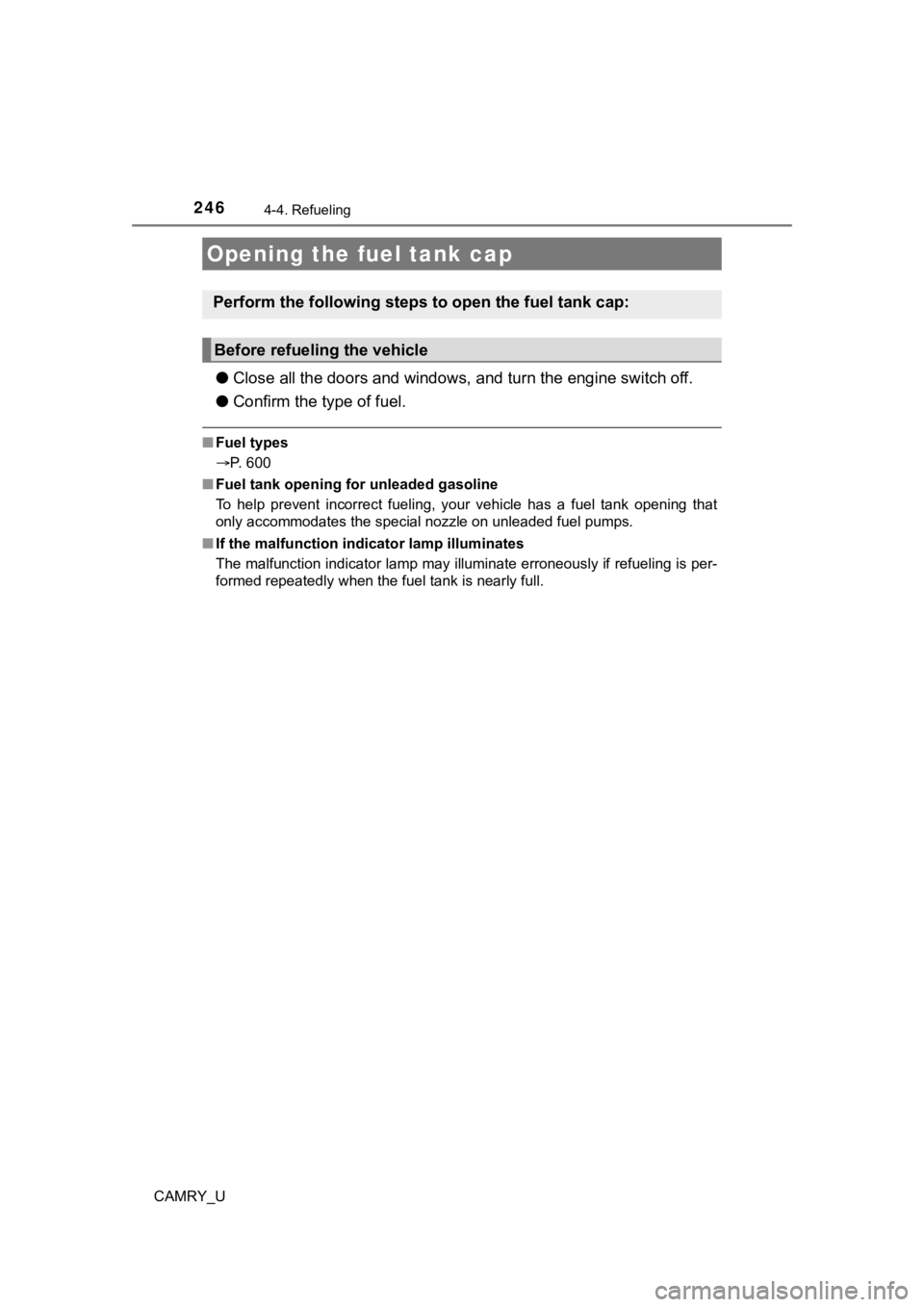
246
CAMRY_U
4-4. Refueling
●Close all the doors and windows, and turn the engine switch off.
● Confirm the type of fuel.
■Fuel types
P. 600
■ Fuel tank opening for unleaded gasoline
To help prevent incorrect fueling, your vehicle has a fuel tank opening that
only accommodates the special nozzle on unleaded fuel pumps.
■ If the malfunction indicator lamp illuminates
The malfunction indicator lamp may illuminate erroneously if re fueling is per-
formed repeatedly when the fuel tank is nearly full.
Opening the fuel tank cap
Perform the following steps to open the fuel tank cap:
Before refueling the vehicle
Page 247 of 660
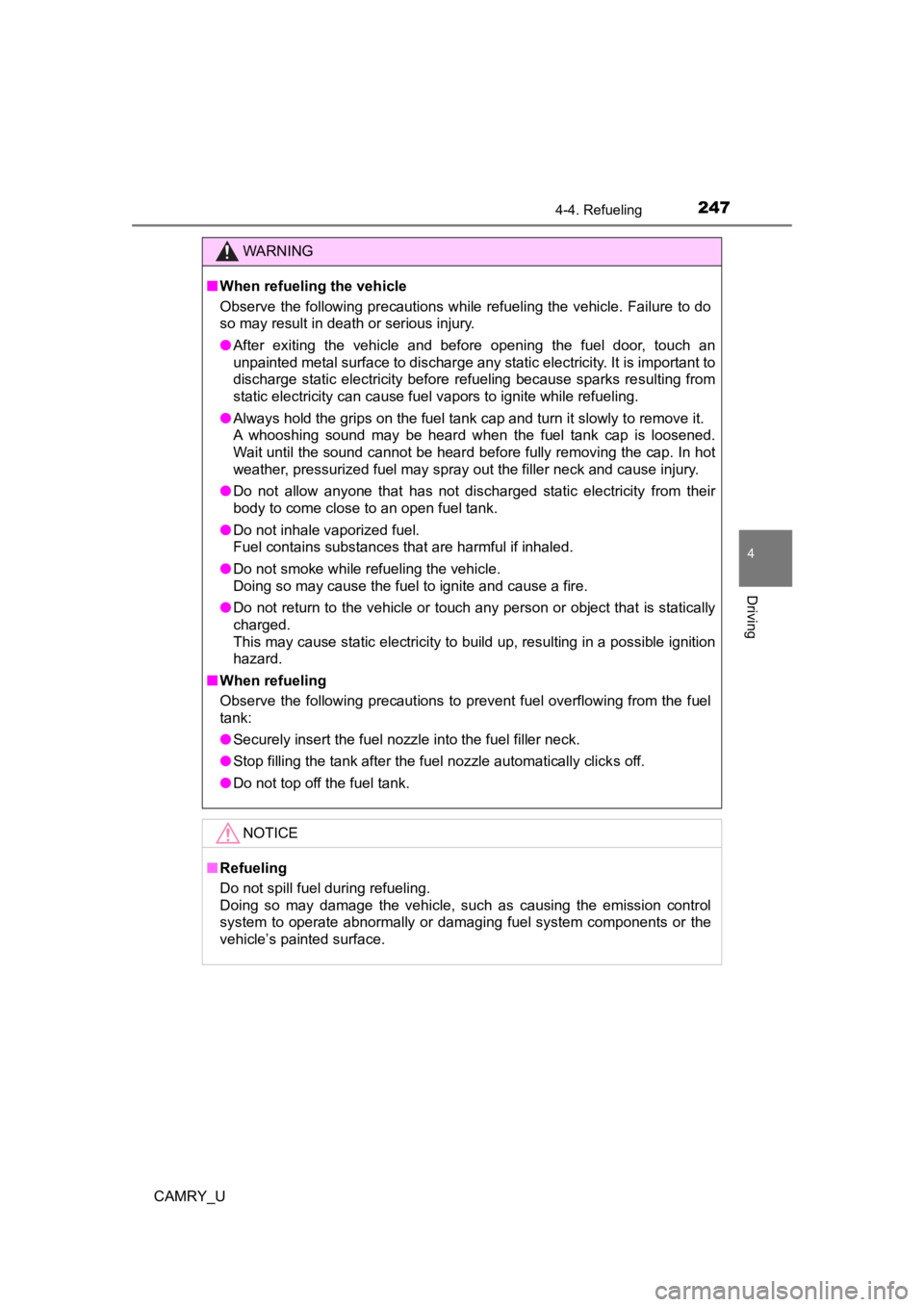
2474-4. Refueling
4
Driving
CAMRY_U
WARNING
■When refueling the vehicle
Observe the following precautions while refueling the vehicle. Failure to do
so may result in death or serious injury.
● After exiting the vehicle and before opening the fuel door, touch an
unpainted metal surface to discharge any static electricity. It is important to
discharge static electricity before refueling because sparks resulting from
static electricity can cause fuel vapors to ignite while refueling.
● Always hold the grips on the fuel tank cap and turn it slowly t o remove it.
A whooshing sound may be heard when the fuel tank cap is loosened.
Wait until the sound cannot be heard before fully removing the cap. In hot
weather, pressurized fuel may spray out the filler neck and cau se injury.
● Do not allow anyone that has not discharged static electricity from their
body to come close to an open fuel tank.
● Do not inhale vaporized fuel.
Fuel contains substances that are harmful if inhaled.
● Do not smoke while refueling the vehicle.
Doing so may cause the fuel to ignite and cause a fire.
● Do not return to the vehicle or touch any person or object that is statically
charged.
This may cause static electricity to build up, resulting in a p ossible ignition
hazard.
■ When refueling
Observe the following precautions to prevent fuel overflowing from the fuel
tank:
● Securely insert the fuel nozzle into the fuel filler neck.
● Stop filling the tank after the fuel nozzle automatically click s off.
● Do not top off the fuel tank.
NOTICE
■Refueling
Do not spill fuel during refueling.
Doing so may damage the vehicle, such as causing the emission c ontrol
system to operate abnormally or damaging fuel system components or the
vehicle’s painted surface.
Page 248 of 660
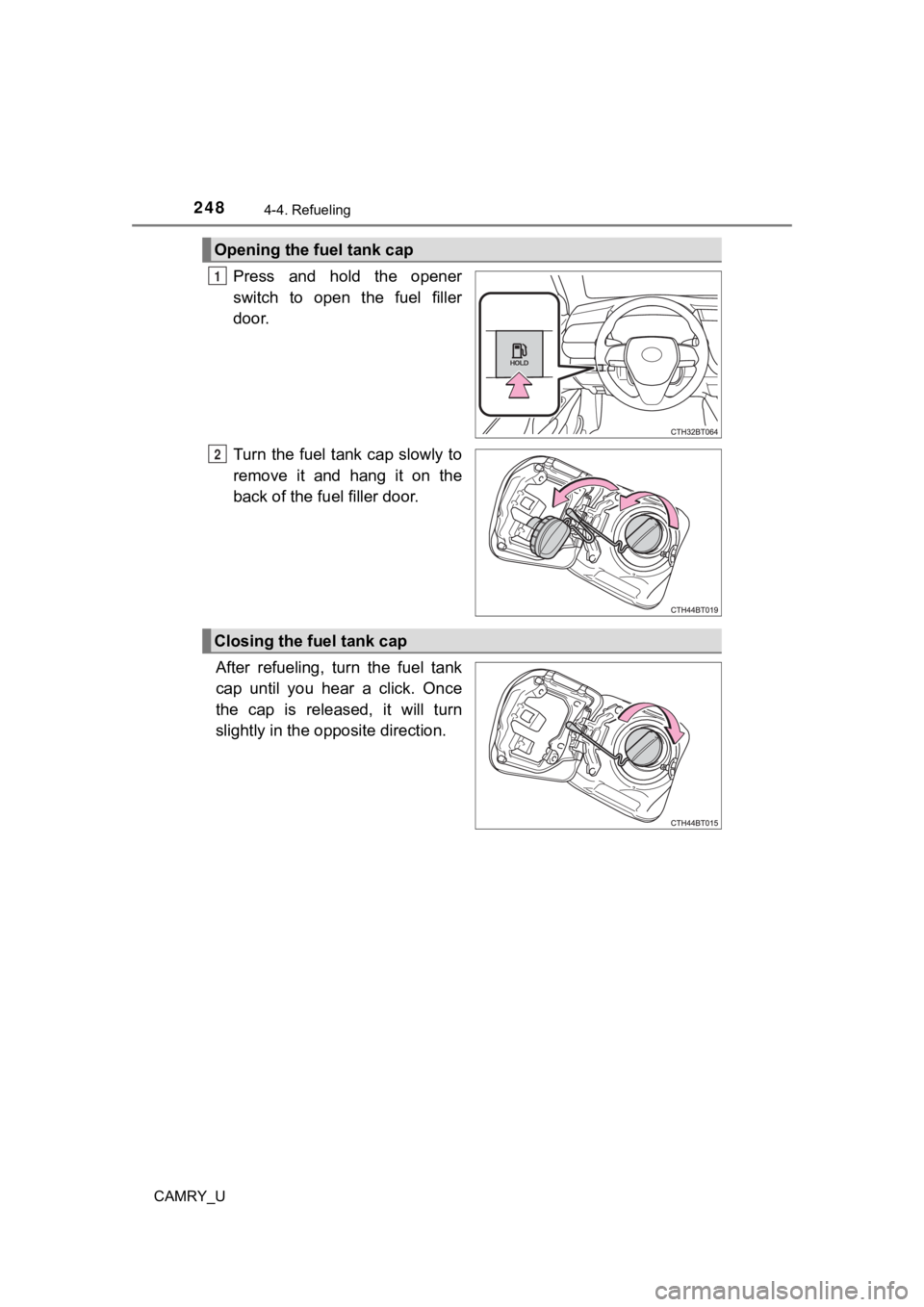
2484-4. Refueling
CAMRY_U
Press and hold the opener
switch to open the fuel filler
door.
Turn the fuel tank cap slowly to
remove it and hang it on the
back of the fuel filler door.
After refueling, turn the fuel tank
cap until you hear a click. Once
the cap is released, it will turn
slightly in the opposite direction.
Opening the fuel tank cap
1
2
Closing the fuel tank cap
Page 249 of 660
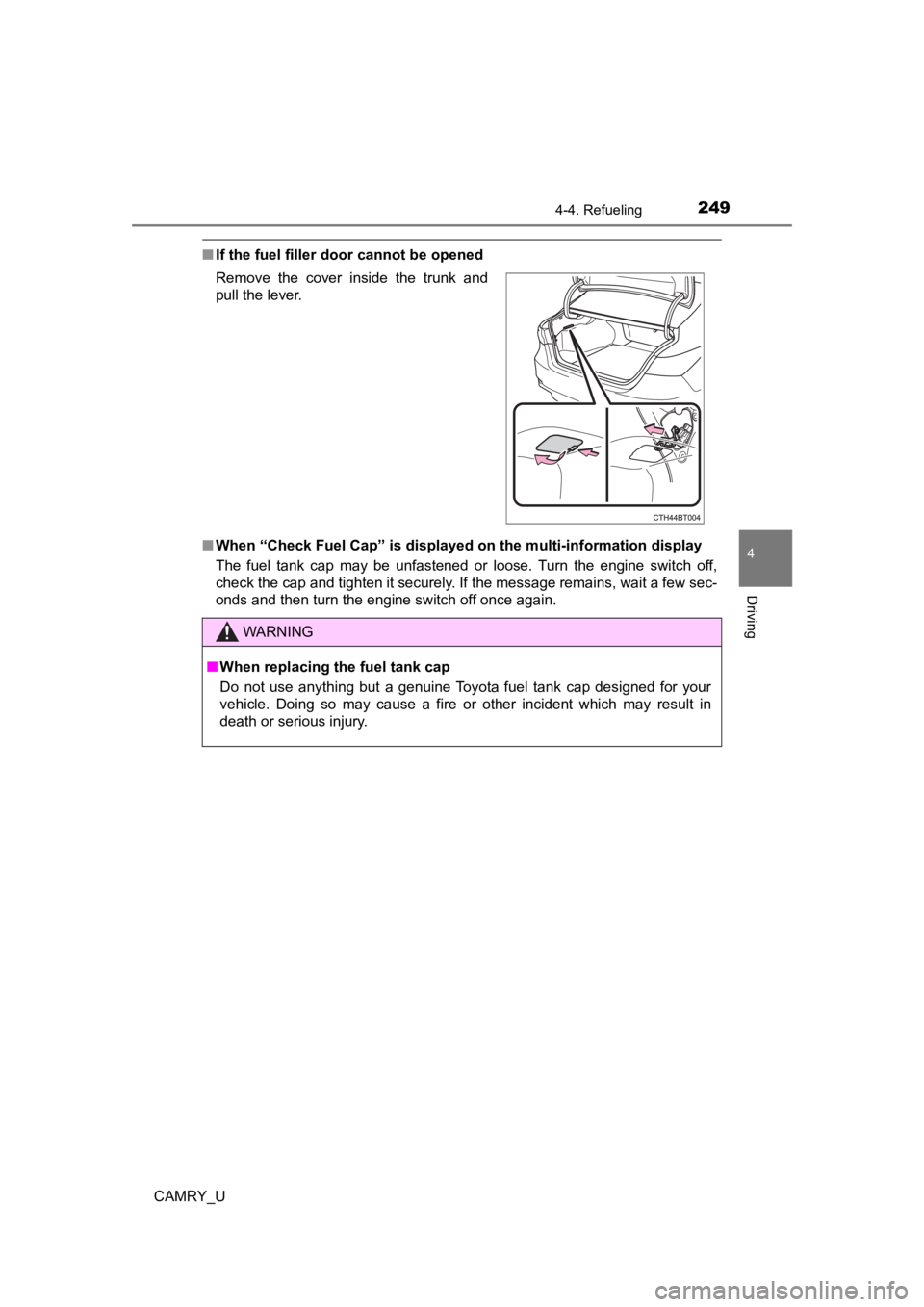
2494-4. Refueling
4
Driving
CAMRY_U
■If the fuel filler door cannot be opened
■ When “Check Fuel Cap” is displayed on the multi-information dis play
The fuel tank cap may be unfastened or loose. Turn the engine switch off,
check the cap and tighten it securely. If the message remains, wait a few sec-
onds and then turn the engine switch off once again. Remove the cover inside the trunk and
pull the lever.
WARNING
■ When replacing the fuel tank cap
Do not use anything but a genuine Toyota fuel tank cap designed for your
vehicle. Doing so may cause a fire or other incident which may result in
death or serious injury.
Page 463 of 660
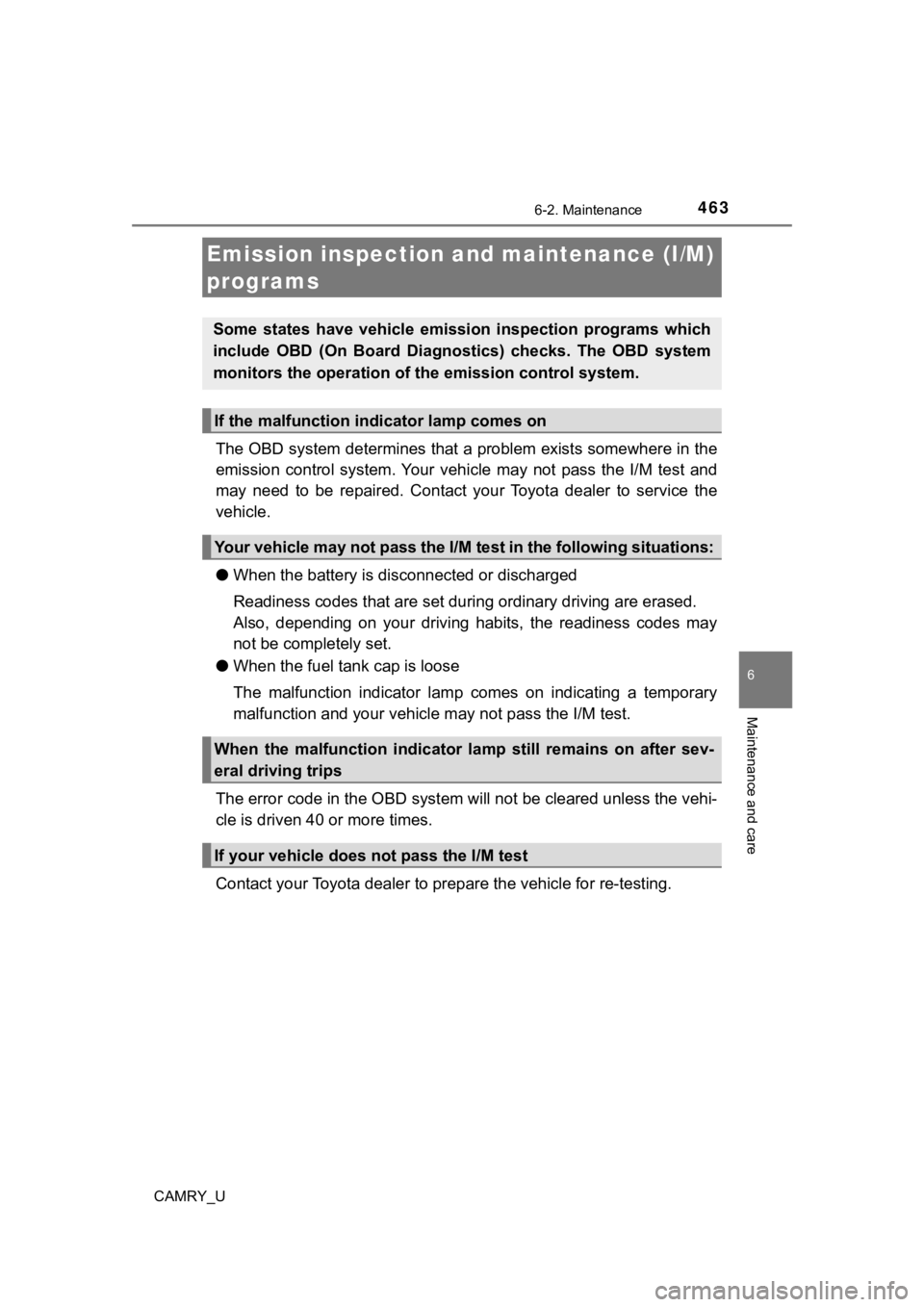
4636-2. Maintenance
CAMRY_U
6
Maintenance and care
The OBD system determines that a problem exists somewhere in the
emission control system. Your vehicle may not pass the I/M test and
may need to be repaired. Contact your Toyota dealer to service the
vehicle.
● When the battery is disc onnected or discharged
Readiness codes that are set duri ng ordinary driving are erased.
Also, depending on your driving habits, the readiness codes may
not be completely set.
● When the fuel tan k cap is loose
The malfunction indicator lamp comes on indicating a temporary
malfunction and your vehicle m ay not pass the I/M test.
The error code in th e OBD system will not be cleared unless the vehi-
cle is driven 40 or more times.
Contact your Toyota dea ler to prepare the vehicle for re-testin g.
Emission inspection and maintenance (I/M)
programs
Some states have vehicle emission inspection programs which
include OBD (On Board Diagnos tics) checks. The OBD system
monitors the operation of t he emission control system.
If the malfunction indicator lamp comes on
Your vehicle may not pass the I/M test in the following situations:
When the malfunction indicator lamp still remains on after sev-
eral driving trips
If your vehicle does not pass the I/M test